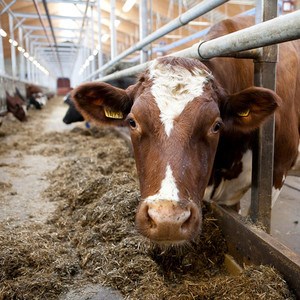New doctoral thesis about dry period length in dairy cows

How does the length of the dry period affect milk yield, health and fertility in dairy cows? In a new doctoral thesis by Lisa Andrée O'Hara, cows with a shorter dry period had a lower milk yield in early lactation, but when the milk produced before parturition was counted, the difference decreased. Energy balance and metabolism status improved with shorter dry period.
The transition from not producing milk during the dry period to the huge nutrient demands as milk production rapidly increases after parturition imposes significant metabolic strain on high-yielding dairy cows .The drying-off procedure is also demanding and high milk yield at dry -off increases the risk of mastitis and metabolic problems. A dry period of approximately 8 weeks is generally recommended, but a shorter dry period might reduce the metabolic strain on high-yielding cows at dry-off and in early lactation.

Lisa Andrée O´Hara defended her thesis on September 27. Photo: Marie Liljeholm, SLU
This thesis investigated the effects of different dry period lengths on the health and performance of two cow breeds. An experimental trial was conducted in which multiparous Swedish Red (n=43) and Swedish Holstein (n=34) cows were blocked by breed and parity, and then randomly allocated to two different treatments; a conventional DP of 8 weeks (8W) or a short DP of 4 weeks DP (4W).
An observational study was performed using data on 78 577 lactations from cows enrolled in the Swedish Official Milk Recording Scheme.The experimental and observational studies both showed that shortening the dry period resulted in a reduction in milk yield during the following lactation. However, when the milk produced during the extended lactation was added, the difference diminished. Feed intake was virtually identical between cows subjected to a short and conventional dry period. The reduced milk production while feed intake was maintained in 4W cows improved their energy balance markedly. Cyclicity and commencement of luteal activity was not affected by dry period length in the experimental study and no effects of dry period on health and fertility traits were observed in the observational study. However, culling rate was lower in cows with a shorter dry period. Cows of the different breeds and of different parities responded similarly to changes in dry period. The volume of colostrum was reduced, but the protein content was higher, in cows with a short dry period. The Immunoglobulin G status of calves was not affected by the dry period of their dam. Tests on dry period >70 days showed it was not favourable, due to low milk production, increased risk of culling and decreased fertility.
In conclusion, this thesis shows that energy balance and metabolic status improve, but not health and fertility, in cows subjected to a short dry period. The reduction in milk yield after calving is compensated for by additional yield prior to calving.